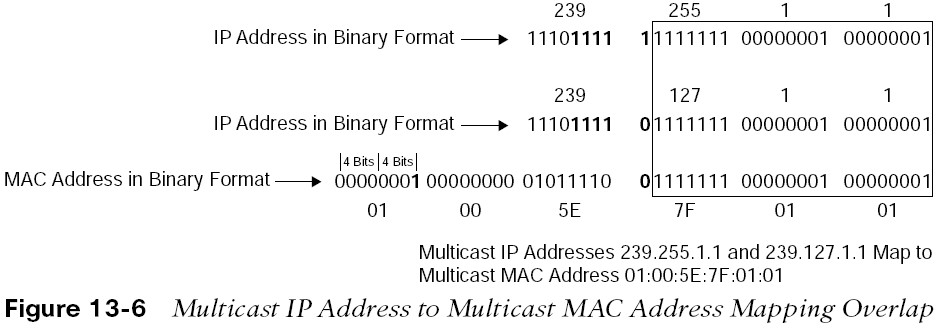
Multicast Addressing
describes the multicast address scopes used by multicast to operate at Layer 2 and Layer 3.
- The Internet Assigned Number Authority (IANA) assigned the IP Class D address space 224.0.0.0/4 for multicast addressing. It includes addresses ranging from 224.0.0.0 to 239.255.255.255.
- The first 4 bits of this whole range start with 1110.
Class D Addressing
| Designation | Multicast Address Range |
| Local network control block | 224.0.0.0 to 224.0.0.255 |
| Internetwork control block | 224.0.1.0 to 224.0.1.255 |
| Ad hoc block | 224.0.2.0 to 224.0.255.255 |
| Reserved | 224.1.0.0 to 224.1.255.255 |
| SDP/SAP block | 224.2.0.0 to 224.2.255.255 |
| Ad hoc block II | 224.3.0.0 to 224.4.255.255 |
| Reserved | 224.5.0.0 to 224.255.255.255 |
| Reserved | 225.0.0.0 to 231.255.255.255 |
| Source Specific Multicast (SSM) block | 232.0.0.0 to 232.255.255.255 |
| GLOP block | 233.0.0.0 to 233.251.255.255 |
| Ad hoc block III | 233.252.0.0 to 233.255.255.255 |
| Reserved | 234.0.0.0 to 238.255.255.255 |
| Administratively scoped block | 239.0.0.0 to 239.255.255.255 |
- Local network control block (224.0.0/24) Addresses in the local network control block are used for protocol control traffic that is not forwarded out a broadcast domain.
- Internetwork control block (224.0.1.0/24) Addresses in the internetwork control block are used for protocol control traffic that may be forwarded through the Internet.
Well–Known Reserved Multicast Addresses
| IP Multicast Address | Description |
| 224.0.0.0 | Base address (reserved) |
| 224.0.0.1 | All hosts in this subnet (all-hosts group) |
| 224.0.0.2 | All routers in this subnet |
| 224.0.0.5 | All OSPF routers (AllSPFRouters) |
| 224.0.0.6 | All OSPF DRs (AllDRouters) |
| 224.0.0.9 | All RIPv2 routers |
| 224.0.0.10 | All EIGRP routers |
| 224.0.0.13 | All PIM routers |
| 224.0.0.18 | VRRP |
| 224.0.0.22 | IGMPv3 |
| 224.0.0.102 | HSRPv2 and GLBP |
| 224.0.1.1 | NTP |
| 224.0.1.39 | Cisco-RP-Announce (Auto-RP) |
| 224.0.1.40 | Cisco-RP-Discovery (Auto-RP) |
- Source Specific Multicast (SSM) block (232.0.0.0/8): This is the default range used by SSM. SSM is a PIM extension described in RFC 4607.
- GLOP block (233.0.0.0/8): Addresses in the GLOP block are globally scoped statically assigned addresses.
- Administratively scoped block (239.0.0.0/8): described in RFC 2365, are limited to a local group or organization. Similar to the reserved IP unicast ranges (such as 10.0.0.0/8) and will not be assigned by the IANA.
Layer 2 Multicast Addressing
Every multicast group address (IP address) is mapped to a special MAC address that allows Ethernet interfaces to identify multicast packets to a specific group. A LAN segment can have multiple streams, and a receiver knows which traffic to send to the CPU for processing based on the MAC assigned to the multicast traffic.
- The first 24 bits of a multicast MAC always start with 01:00:5E.
- The low-order bit of the first byte is the individual/group bit (I/G) bit, also known as the unicast/multicast bit.
- When it is set to 1, it indicates that the frame is a multicast frame, and the 25th bit is always 0.
- The lower 23 bits of the multicast MAC address are copied from the lower 23 bits of the multicast group IP address.
 Out of the 9 bits from the multicast IP that are not copied into the multicast MAC, the high-order bits 1110 are fixed; that leaves 5 bits that are variable that are not transferred into the MAC. Because of this, there are 32 (25) multicast IP addresses that are not universally unique and could correspond to a single MAC.
Out of the 9 bits from the multicast IP that are not copied into the multicast MAC, the high-order bits 1110 are fixed; that leaves 5 bits that are variable that are not transferred into the MAC. Because of this, there are 32 (25) multicast IP addresses that are not universally unique and could correspond to a single MAC.
Layer 2 Address Mapping Overlap

Other useful information: